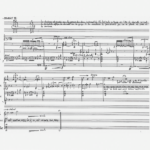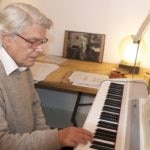Georges Aperghis named Frontiers Award winner for reinventing musical theater
Greek composer Georges Aperghis honored with the BBVA Foundation's Frontiers of Knowledge Award in Contemporary Music for reinventing musical theater through the use of sounds, gestures, technologies and spaces, and incorporating performers into the creative compositional process.

The jury of the award, which announced its decision at BBVA Foundation’s headquarters in Madrid, praised George Aperghis (Athens, 1945) for “opening up a unique path in the territory of musical theater employing new scenic devices whereby everything becomes music, starting from the performer’s gestures and including sounds made by scenic elements or objects used as percussion instruments.”
The Paris-based musician has revolutionized musical theater, by opening it to other arts - such as choreography, performance or videoart – and through the use of electronic devices, including robots.
Aperghis’ musical theater has drawn in new audiences and succeeded at making contemporary music part and parcel of the broader theatrical experience. The jury also makes a parallel between the spirit of these awards and the power of the new laureate’s works to dissolve the frontiers between theater and music. As Aperghis himself explained yesterday: “For me, there are no boundaries between music and theater, but a continuum in which the dramatic action is a prolongation of the music and the music contains the action.”

A self-taught composer
Born in Athens in 1945, George Aperghis never underwent formal musical training. At the age of 17, he moved to Paris, where he discovered the world of stage and encountered serialism at the Domaine Musical concerts, the musique concrete of Pierre Schaeffer and Pierre Henry, and the work of Iannis Xenakis, which inspired his early compositions.
By 1970, he was seeking a freer kind of language and began his explorations of vocal sounds. His growing interest in musical theater led to the 1971 work La tragique histoire du nécromancien Hiéronimo et de son miroir. Wedding text, music and stagecraft, it marked out an innovative course that he would later summarize as follows: “If there is one idea I’m attached to it is this: never go back to the past and to what has been done during the years since the Second World War.”
The emotion we feel seeing a robot crying
He began to work with new technologies in the 1990s, using the video, electronic and real-time sound processing resources of the Institut de Recherche et Coordination Acoustique/Musique (IRCAM): “I can do things with electronics that the voice cannot do. I can extend a spoken sound over a long time, I can have a long chain of words from the voice, I can manipulate registers, I can superimpose voices, etc., but also arrange syllables in a sort of a haphazard treatment. There is a musical poetic peculiar to electronics. It is the same kind of emotion we feel when seeing a robot crying or dying.”
Despite being author, director and composer of his shows, Aperghis makes sure that every performer, instrumentalist, actor, singer or dancer, is part of the creative process. “He is not a conventional musician who presents the performers with a closed score,” explains a member of the jury. “Instead he works alongside them in a process of inquiry that gives rise to a kind of ‘hybridization’, with actors becoming musicians and vice versa,” explained the jury.
Aperghis pursues a universal language where text is unimportant and words make way for onomatopoeia, phonemes and noise. This fragmentation is echoed in surreal stage productions in which the author at times creates imaginary languages on the borders of sound poetry.
Even his instrumental music resembles his voice recitations, in that rather than pursuing meaning it finds its purpose in confrontation with the public, teasing them with paradoxes and playful elements that induce a reaction or reflection.